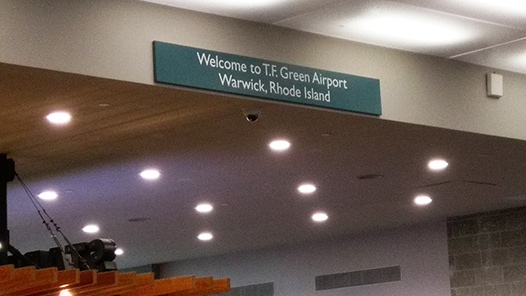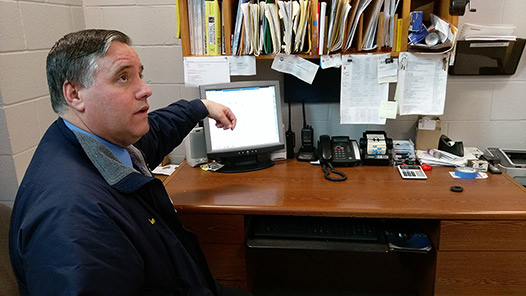 For almost 25 years, the Rhode Island Airport Corporation (RIAC) has operated and maintained the Ocean State's airport system. Its board members are appointed by the governor to oversee design, construction, operation, and maintenance of six state-owned airports. The largest and most active of these airports is T. F. Green Airport, located near Providence, which serves nearly four million passengers annually.
For almost 25 years, the Rhode Island Airport Corporation (RIAC) has operated and maintained the Ocean State's airport system. Its board members are appointed by the governor to oversee design, construction, operation, and maintenance of six state-owned airports. The largest and most active of these airports is T. F. Green Airport, located near Providence, which serves nearly four million passengers annually.
Rhode Island has a deep commitment to energy efficiency, and for many years, its flagship airport has reflected that commitment. RIAC aims to make T.F. Green as energy efficient as possible, while always concentrating on giving passengers what they need: easy access, along with modern and dependable service.
Since T.F. Green’s new airport terminal was built in 1996, RIAC participated in several energy efficiency lighting upgrades on all 12 of the airport’s buildings.
In 2008 the State of RI Energy Office was promoting the use of an Energy Service Company (ESCO) as part of a Federal Energy Office to Rebuild America Campaign. Three ESCO’s from the State of RI Master Price Agreement list were asked to review our Terminal and provide us with proposals of Energy saving projects. After reviewing the three presentations a RIAC selection committee identified Con Edison Solutions as the preferred firm to develop a full energy audit of all our facilities and present us with a proposal. Con Edison’s proposed 11 Energy Conservation Measures (ECM’s) were approved in 2010 for an Energy Saving Performance Contract (ESPC) with a budget of $5 Million and a 12 year guaranteed return on investment.
The ECM’s consisted of lighting, exhaust controls, central plant efficiency improvements, energy management systems (EMS) upgrade, air economizer and demand control ventilation, Liebert Control improvements, solar domestic hot water, loading dock air infiltration improvements and electric demand control programming. The NGRID Electric and Gas utility rebates for this project were about $428,001 and $161,798 respectively.
The Metering and Verification process for this project involved using a whole Building Computer Simulation or Model referred to as a DOE2.2 where a baseline building simulation was made. After all the improvements were installed, a post simulation was made to confirm the savings were achieved. Verified savings for each ECM is determined from calibrated models for each post installation year. Total verified savings for each ECM are reported in each annual M&V report.
T.F. Green’s most recent LED lighting project consisted of replacing existing interior and exterior standard lighting at the terminal, interlink, parking garages, parking lots, perimeter roadways, and other buildings encompassing the airport. The LED Lighting project cost about $4 Million Dollars, resulting in $2.3 million in incentives paid for by National Grid and energy savings over a 3 year period

Thanks to the LED lighting, T.F. Green saves more than 5.5 million kWh annually. At the same time, lighting levels for passengers have been maintained, and in most cases, even improved. In the terminal’s main lobby and baggage claims areas, new dimmable LED lighting, reduced to 60-80% of full light output, still produces a much brighter and appealing space for public use. Passengers have also noticed brighter lighting at terminal gate areas, thanks to new LED ceiling lights.
Lighting control was also greatly improved by the use of motion and light level sensors. These sensors are located on each light fixture and are programmable via a hand-held remote control. The lights can individually maintain a certain light level when the space is occupied, but go to a lower level when the space is vacant. The lights even go off when the daylight level exceeds the lighting level requirements for occupied space.
The LEDs have also improved safety for passengers and airport personnel, because the lights can be turned on or off immediately as needed. (The older HID lights took as long as 15 minutes to come back on after being shut off.) These “instant on” lights are located in areas like parking lots, roadways, terminal ramps, and building exterior perimeters.
RIAC was well aware that, for a project of this magnitude to succeed, a dedicated team effort was needed to plan and collaborate on every detail. RIAC, in partnership with National Grid, utilized Energy Source as the LED project expediter, and Collard Enterprises, Inc. as the electrical contractor. By working together with all vested partners, including the end users, coordinators completed the LED upgrades with very timely and satisfactory results. The lighting projects have substantially impacted the airport’s “bottom line” as well. Each year, T.F. Green saves more than $1 million on electric and gas usage.
Buoyed by the success at T.F. Green, RIAC plans to expand energy efficiency projects at other Rhode Island airports. This includes developing solar facilities at T.F. Green, as well as Newport, Quonset, and North Central airports.
With its eyes on the future, and with National Grid and trusted partners as co-pilots, RIAC will make sure these projects are ready for take-off.
| Savings | |
| Annual energy savings (kwh/yr): | 8,615,613 |
| Total savings ($): | 855,276 |
| Total project cost ($): | 4,121,705 |
| Incentive dollars ($): | 3,009,584 |
| Customer cost ($): | 1,838,747 |
| Simple payback (yrs): | 2.2 |
